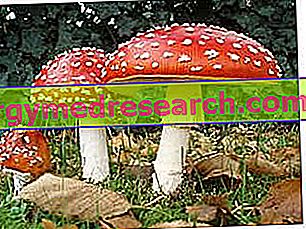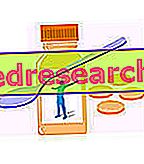Generality
Opisthotonus is the term used to indicate a severe state of spastic rigidity that leads the patient to assume an unnatural arched position .

More in detail, the opisthotonos is a symptom related to different pathological conditions, to the taking of some medicines or to poisoning by some toxic substances, such as strychnine.
The opisthotonos is characterized by a marked and uncontrolled contracture of the skeletal muscles located in the posterior part of the body, due to which the patient assumes a typical "arched" position.
Clearly, since it is a symptom, the resolution of opisthotonos is closely related to the treatment or treatment of the underlying cause that triggered it.
What is that
What is the Opistotonus?
In medical language, the term "opisthotonos" is used to indicate a condition in which the body is in a hyperextension situation caused by the prevalent contracture of the extensor skeletal muscles on the flexors . This contracture mostly involves the muscles present on the back of the trunk and causes the affected individual to assume an unnatural position commonly defined as "arched", "arched" or "bridged".
As mentioned, the opisthotonos is a symptom that can be caused by different pathologies, or it can manifest itself following poisoning with some types of substances or following the assumption of some drugs (in this case, therefore, the opisthotonus assumes the side-effect character).
Causes
What are the Causes of Opisthotonos?
Opisthotonus is a condition that can be caused by factors of a different nature. These factors can give rise to lesions or alterations in the central nervous system, or they can alter (or better, decrease) the excitability threshold of the spinal cord motor cells. The consequence of similar alterations and / or injuries induced consists in the marked contraction of the skeletal muscles located along the vertebral column and in the onset of opisthotonus.
Opisthotonos as Symptom of Pathologies
As mentioned, the opisthotonus can manifest itself as a symptom of some pathologies, among which we recall:
- Tetanus : tetanus is a serious bacterial disease caused by a toxin released by beating Clostridium tetani . This toxin is able to hinder the activity of two neurotransmitters with inhibitory function - such as glycine and GABA - favoring the contraction of the striated muscles with the consequent appearance of spasms, rigidity and, in fact, opisthotonos.
- Meningitis : the opisthotonus is a typical symptom also of some forms of meningitis, that is to say of particular inflammatory pathologies of the meninges (the lining membranes of the central nervous system with a protective function against encephalon and spinal cord). In particular, the opisthotonos seems to manifest itself above all in children affected by this disease.
- Arnold-Chiari syndrome : it is a pathology characterized by a malformation of the posterior cranial fossa. There are four different types of this syndrome, each with its own symptomatology. Opisthotonus tends to manifest itself in particular in Arnold-Chiari type II syndrome, a symptomatic form from birth.
- Neonatal jaundice: the opisthotonos also occurs in newborns suffering from jaundice. The symptom is induced by the accumulation of bilirubin at the level of the nuclei of the base.
- Maple syrup urine disease : this is a rare genetic disorder with autosomal recessive transmission, characterized by a deficiency of the branched chain alpha-keto acid dehydrogenase enzyme. The disease manifests itself from early childhood with the appearance of several symptoms, including, in fact, the opisthotonos.
Did you know that ...
Opisthotonus may also occur following discontinuation of cardio-respiratory support in individuals who have been diagnosed with irreversible coma .
Opisthotonos as a Result of Poisoning or Poisoning
In some cases, opisthotonos may not be the symptom of a disease, but the consequence of poisoning or intoxication. Among the substances that can give rise to poisonings or intoxications capable of triggering opisthotonos, we recall:
- Stricnina : it is a very toxic alkaloid contained within the seeds of the plants belonging to the genus Strychnos . Severe strychnine intoxication can give rise to opisthotonos. The symptom is due to the competitive antagonist activity against glycine, an inhibitory neurotransmitter of the central nervous system. Because of this activity, strychnine prevents glycine from binding to its receptors, with consequent onset of muscle contractions and opisthotonos.
- Ignatia amara and nut vomica : they are plants belonging to the genus Strychnos, therefore containing strychnine and other toxic alkaloids such as brucina . Therefore, the intake of these plants, their seeds or derivatives of any kind is capable of giving rise to poisoning or poisoning which, in turn, can cause opisthotonos.
- Lithium : in some cases, opisthotonos may also occur in the presence of lithium intoxication.
Opisthotonos as a side effect of drugs
Occasionally, opisthotonos can manifest themselves after taking certain types of drugs. Different are the active ingredients for which the opisthotono constitutes a known side effect; among these we remember:
- Levomepromazine, an antipsychotic drug used in the treatment of schizophrenia, paranoid states, mania, toxic psychosis and delusions. It is also used against unstoppable nausea and hiccups and in case of very intense pain in association with analgesics.
- Chlorpromazine and perphenazine, other antipsychotics with therapeutic indications similar to those of the aforementioned levomepromazine.
- Clotiapine, an atypical antipsychotic used in the treatment of acute and chronic psychosis.
- Risperidone, another antipsychotic active ingredient used in the treatment of schizophrenia, mania and aggression in patients suffering from Alzheimer's disease.
- Oxatomide, an antihistamine used in the treatment and prevention of various allergic disorders, such as rhinitis, asthma, conjunctivitis, atopic dermatitis and food allergies.
Other Causes
In conclusion, we recall that, in some cases, opisthotonos can occur following more or less severe traumatic brain injuries .
How it manifests
Manifestations of the Opistotono and Associated Symptoms
The patient with opisthotonus shows a marked contraction of the axial skeletal muscles located along the entire vertebral column leading to a hyperextension condition. This hyperextension causes the individual to assume an unnaturally arched posture . More in detail, the opisthotonos patient - when he is in the supine position - assumes an "arched" or "bridge" position in which only the head (possibly, together with the neck and shoulders) and heels are in contact with the base of support on which it is found.
The contraction and muscular stiffness that characterize the opisthotonos can be accompanied by a more or less intense sensation of pain, variable according to the cause that triggered the symptom.
In some cases, the opisthotonos can also be associated with an extension of the four limbs ( decerebral rigidity ).
Finally, depending on the cause that gave rise to opisthotonus, the patient may also experience other characteristic symptoms (for example, very high fever in the case of meningitis; mandibular stiffness in the presence of tetanus; convulsions and difficulty in walking in the case of syndrome of Arnold-Chiari type II, agitation, restlessness and muscle spasms in case of strychnine poisoning, etc.).
Factors that Favor the Appearance of Opisthotonos
In the presence of one of the triggering causes, the opisthotonus can manifest itself as a result of stimuli of different types - such as tactile, visual or acoustic stimuli - or following any attempt at movement (signs of the head, attempt to grab objects and even, attempt to talk, smile or eat).
Diagnosis
Importance of Diagnosis in the presence of Opistotono
The diagnosis of opisthotonos is made substantially on the basis of the patient's medical history and examination. Once the presence of this symptom has been ascertained, the doctor will then have to identify what caused it.
Indeed, since the opisthotonus can manifest itself following the most disparate causes (pathologies, poisonings or intoxications, side effects), when a patient manifests this symptom - all the more so if it is a question of children or babies - the execution of a correct diagnosis is of the utmost importance for identifying the most suitable therapeutic strategy for each case.
In order to provide a correct diagnosis, the doctor may decide to resort to the use of various analyzes and diagnostic tests, such as, for example, blood tests, CT scans, MRIs, etc.
Care and Treatment
Is there a cure for the Opistotonus?
Being a symptom, the treatment of opisthotonos is inextricably linked to the care and treatment of the cause that gave rise to it.
Clearly, when a patient manifests an opisthotonos, it is necessary to contact the medical help immediately because hospital assistance is necessary.
In some situations, the doctor may decide to resort to the use of muscle relaxants in order to counteract muscle stiffness and contraction, thus relieving the patient. However, similar medicines have only a temporary effect, while to prevent new manifestations of opisthotonus it is essential to eliminate the triggering cause.



